Know you need to catalog your art collection, but don’t know where to start?
Digitizing your art collection helps to organize, safeguard and manage your investment. Plus, it isn’t the headache you think it is.
We’ve broken it down into ten simple steps to make it even easier with Artwork Archive’s collection management tools. You don’t need to be a collections manager or archivist with a degree in Library and Information Science to get it done. Heck, you don’t need a background in art history either. Whether you’ve been managing your collection for decades or just got your hands on a body of artwork, you can easily get it all organized.
You’ll be so glad you took the time to do it. When you’re done you’ll have a living archive in Artwork Archive—tracking every single piece you’ve owned, where it has lived, all of your contacts, financial documents, appraisals and more.
This organizational bliss will free you up to do more whether that is the 273,864 other tasks on your plate this week, or going out and buying more art to add to your collection!
Work backwards.
It can seem overwhelming to inventory an entire collection, so we recommend working backwards. That way you’ll start with the art that is freshest in your mind. And, you'll have details on hand for questions about recent acquisitions. Then you can take a trip down memory lane and archive your older pieces.
Take high-quality photographs.
While this may seem obvious, it is tempting to type in the artist name and title of a piece and be done with it. Don’t fall for that trap! It is so important to have an image of your work, especially if the piece lives in a separate building, second home, or resides in another part of town.
As the years go by and your collection grows, it can be easy to forget which painting goes with what title. It’s also nice to have beautiful, high-quality images of your work to send to those managing your estate (accountants, attorneys, art advisors) as well as potential buyers and galleries. You can quickly send them the images using the Artwork Archive inventory report or portfolio page feature.
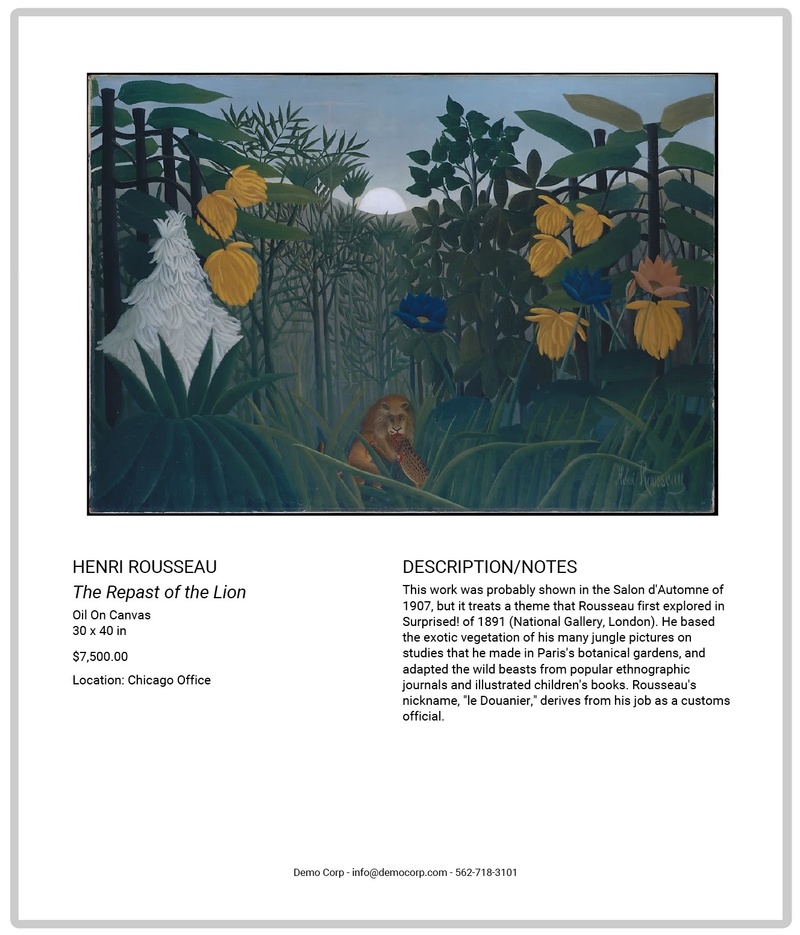
Inventorying your collection with beautiful photos and the right information lets you send stakeholders what they need in a snap.
Add in the provenance details.
You’ll need to record the title, artist name, dimensions, creation date, price, medium, and subject matter to have a detailed provenance record for each piece. There is plenty more information to add to your piece record if you wish: the work's condition, signature notes, acquisition details, etc.
You can upload up to 20 pieces at once using our Bulk Upload feature and fill in the title, artist name, and price as they upload. Then you can add in the rest of the information later.
Take notes on each piece.
Record the description of each piece. These can be thoughts shared by the artist while they were creating the artwork—inspirations, materials used, etc. You can jot specific notes about how the work came into your collection and record any information that will help support the authenticity and provenance of the work.
Assign your work to a location.
Once you’ve logged all of your pieces into the art collection management software you can assign each piece to a location. That way you’ll always know in which home, building, office, park, your work resides. And, if your works are on loan, you'll have a record to remind you, as well as be able to build out the rich exhibition history of the work—boosting its perceived value.
You’ll have the location at the ready if a colleague, family member or estate planning attorney needs the information. You’ll also be able to see the spread of your investment in the Insights tool where the purchase and market values of each work, along with their locations, are outlined for you to review at a glance.
If you're managing a public art program or a collection without formal addresses (i.e. sculptures in a park), then enter the GPS coordinates.
Add important contacts.
Then you can add in important contacts so you have the details of your artists, appraisers, lawyers, curators, gallery owners, conservators, all in one place. That way you can access them anytime, anywhere as well as connect them to specific pieces within your collection. You can keep them updated by sharing key documents or reports directly from your account.
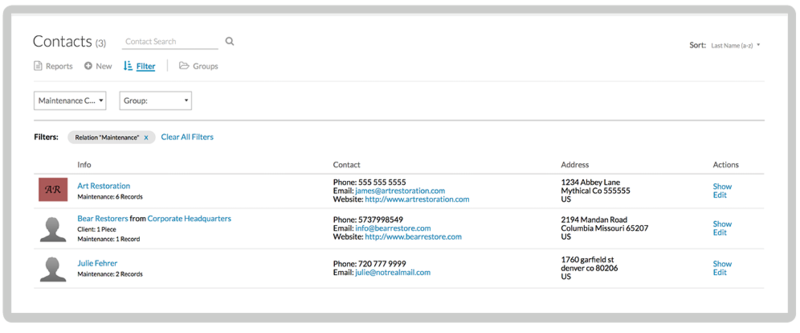 Organize contact details so you never have to stress about searching for important information in emergency situations.
Organize contact details so you never have to stress about searching for important information in emergency situations.
Register purchases, sales and donations.
Maintain better bookkeeping with Artwork Archive as you log purchases, sales and donations. You can assign the transactions to specific contacts and locations within your account. You’ll be able to track all of the important details about your art acquisitions. When it comes to selling or donating, you’ll always know who bought what, when, and for how much.
You can also keep track of valuable documents like donation reports, correspondences with the artist, art auction records, and certificates of authenticity.
And did you know that you can generate and send invoices directly from your account?
Have all of this information handy when tax season comes around. It will be here before you know it!
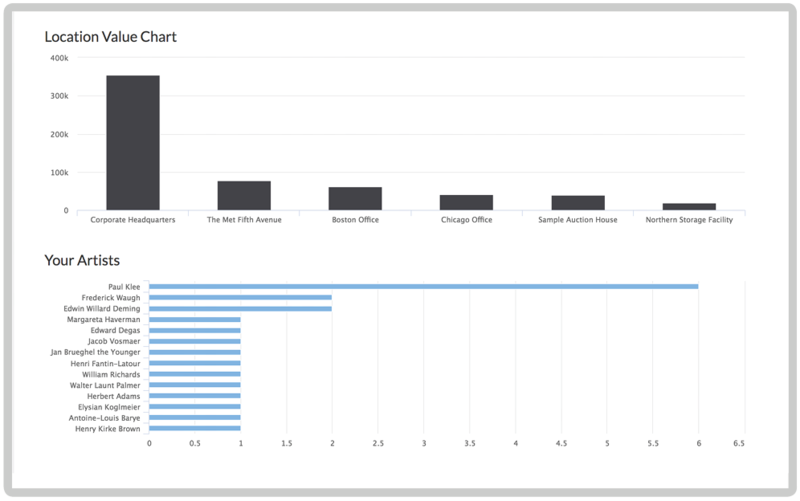
You'll also gain valuable insights into your collection, and see the evolution of your entire collection from initial investment to present day.
With all of this information recorded, you can make informed decisions to enhance the value of your art collection. An informed collector is an intelligent collector.
Upload and track important financial documents.
As mentioned in our article about must-have transaction documents, object documentation is critical since it supports authenticity and passage of clear legal title—proving the value of your piece and bettering your chances for a positive return on your investment.
Your Artwork Archive account gives you the ability to upload important documentation related to your works of art including bills of sale, appraisals, condition reports, press releases and literature pertaining to the artwork and artist.
The advantage of keeping this information online is that you don't have to worry about natural disasters destroying your documentation. You can also easily share documents with those that play a part in managing your investment—financial advisors, attorneys, conservators, art advisors, etc. And, these records will always be accessible for those running your estate.
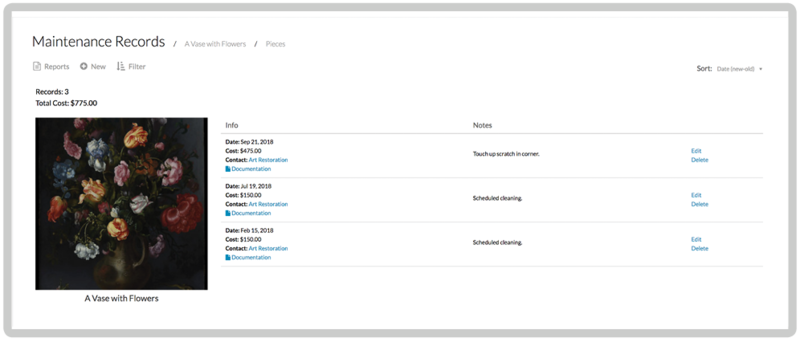 Record maintenance.
Record maintenance.
If you sign up for an Organization account with us, you can track the maintenance and conservation done to your works of art. Record what maintenance happened, who did it, and how much it cost. Upload important files like invoices, conservator notes and images. And, schedule a reminder for upcoming maintenance needs so that you never forget.
This way you can protect and preserve your valuable collection. You’ll always have the assessment and treatment of the work on hand. And, you’ll have an overview of how much it costs to maintain your collection. Learn more about our maintenance tool here.
Enjoy and share your work.
Once you’ve inventoried all your art, you can view your collection on the Artwork Page, share your investment with Artwork Archive’s presentation tools, and create professional reports in a matter of seconds.
With all of your information in one place, you can easily generate comprehensive reports for your insurance company, accountant, estate planner, and/or supervising board. Stop searching through hard drive folders, or even manila folders in a filing cabinet. Free up hours by creating an inventory list with the history and financial details for each piece, and have that report ready when insuring a work or planning a loan.
By default, all of your data is private. But, if you’d like to produce a beautiful online gallery of your collection, you can turn on your Public Profile Page. Viewers can view your portfolio by artist name, collections or an interactive map view.
If you'd like a more exclusive, VIP experience, consider sharing a Private Room. Curate a collection of works and share a password protected page with those interested in the works like potential buyers, galleries, institutions coordinating a loan, estate planners, attorneys, etc.
Moving from another database or already have your info in a spreadsheet? We can import all of that data into your account for you!
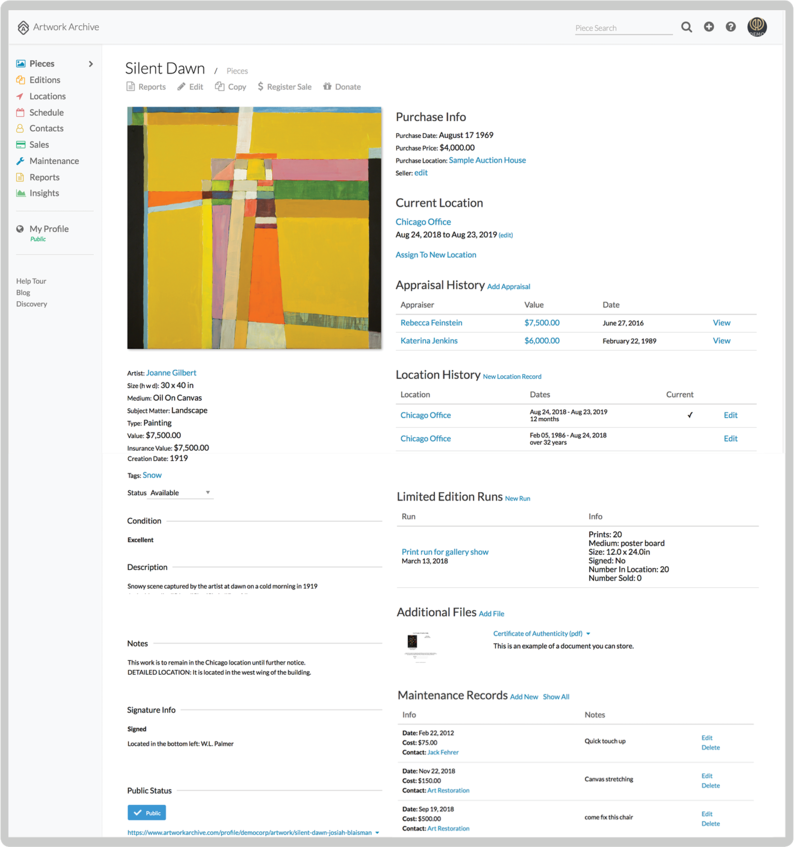 Start organizing your art collection with easy-to-use tools! Try Artwork Archive, free for 14 days, to protect and preserve your investment.
Start organizing your art collection with easy-to-use tools! Try Artwork Archive, free for 14 days, to protect and preserve your investment.







